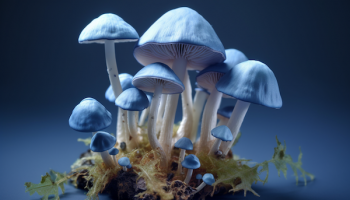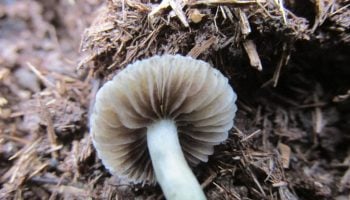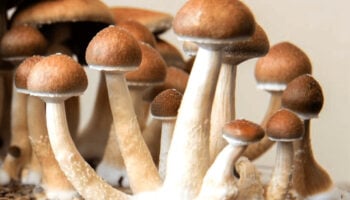The Ultimate Guide to
Microdosing
Psilocybin Truffles
Magic Truffles
Psilocybin is an illegal substance in some places, and we do not encourage or condone the use of this substance where it is against the law. This guide is designed to ensure the safety of those who decide to use this substance legally.
Overview
01Psilocybin truffles (also known as sclerotia) have the exact same chemical composition as psilocybin mushrooms, with identical active compounds – psilocybin, psilocin, and baeocystin. The difference is that truffles are hardened underground buds formed out of mycelial strands which haven’t grown out due to inadequate (or intentionally controlled) conditions.
Many individuals who have integrated microdosing psilocybin truffles into their weekly routine report higher levels of creativity, more energy, increased focus, and improved relational skills, as well as reduced anxiety, stress, and even depression. Some enthusiasts also report that microdosing truffles has helped them heighten their spiritual awareness and enhance their senses.
Psychedelic researchers have also discovered that psilocybin can have positive effects on mood disorders and anxiety. In fact, The Beckley Foundation is spearheading the push for the legalization of psilocybin mushrooms, backed by their research showing that psilocybin has long-term positive effects for treatment-resistant depression patients.
Psilocybin is also proving effective at treating addiction. Researchers from Johns Hopkins found that 80% of smokers who took psilocybin as part of cognitive behavioral therapy were able to quit tobacco completely.
Psilocybin (and LSD) have also been found to have comparable or better results in treating cluster headaches than most conventional medications—many people have experienced extended periods of remission after treating their headaches with psychedelic substances.
With all these encouraging results on full doses of psilocybin, there’s reason to believe that microdosing truffles could bring about similarly positive life changes.
Experience
02How to microdose psilocybin truffles
Ideally, a microdose will not cause a substantial change in mood, disposition, or mindset. Instead, its effect will be subtle but present. To get to this sweet spot, it’s important to find the right dose.
Different strains of truffles will have different psilocybin contents. Usually they’re packaged in 15g boxes, which are with a potency level between 1 and 5. Determining standardized potencies for sclerotia is somewhat trickier than for fully grown mushrooms, but you can assume that 1g of fresh truffles will contain between 0.75 and 1.75mg of psilocybin, adding 0.25mg/g for each higher number on the potency scale.
The most precise way to microdose is to grind a mild to moderate batch of psilocybin truffles into a powder and measure out around 0.25g as a starter dose. You can then adjust the amount accordingly after your first attempt.
Read our full guide on preparing psilocybin mushrooms for microdosing for information on how to best compartmentalize and consume the truffles once you’ve ground them into a powder. Alternately, you can also eat them raw, as they don’t have as earthy of a taste as mushrooms sometimes do.
What schedule should I follow?
Experts in this area suggest different microdosing regimens, but our microdosing course follows James Fadiman’s system. Fadiman recommends taking a microdose once every three days. Take a microdose on Day 1. Then, do not take a microdose on Day 2 or Day 3. On Day 4, take another microdose.

Continue this process for several weeks.
For most people, morning is the best time because the beneficial effects will last throughout the day without interfering with sleep. It’s also helpful to take daily notes in a journal to observe the effects throughout this process and adjust accordingly—or just notice the positive changes.
It’s also important to follow your usual routine while microdosing. The purpose is to enhance your day-to-day existence by integrating microdoses into your routine, so don’t change what you normally do. However, when you try microdosing for the first time, take a day off from work and social commitments. This will give you a chance to notice any unusual effects before microdosing in a more public situation.
While it may seem like you would only feel the effects of the microdose on the days you actually take it, try to observe the effect on the two days between doses, too. Many people perceive increased feelings of flow, creativity, and energy the day after they microdose in addition to the day of microdosing.
Paul Stamets recommends a different microdosing protocol. He suggests taking a microdose every day for four days, then taking three days off to avoid building up a tolerance. He also suggests making psilocybin a central part of a regimen that also includes lions mane and niacin to help with neuroplasticity and general well-being.
Psilocybin and lion’s mane both have the capacity to create new neurons and neural pathways, and also to repair existing neurological damage. Niacin works as a flushing agent and carries GABA across the blood-brain barrier, which helps with the distribution of the psilocybin molecules. All together, Stamets believes that “this unique combination of compounds can be incorporated into other therapies with such combinations providing unique advantages for medically significant advancements in repairing neurons, removing amyloid plaques, improving mental health, cognition, agility, and improving overall the ecology of consciousness.”
Microdosing every day is not recommended. Because your body produces a tolerance to psilocybin, you might see diminishing returns after a few days if they are taken every day. This is why Fadiman suggests leaving a couple of days between each dose. Plus, the fact that positive effects can sometimes be felt many days after a microdose is a good reason to space out your doses.
Another downside to microdosing every day is normalizing a very potent substance. You can compare it to the use of coffee for productivity purposes. When you drink coffee every day, over time you need to increase the dose to get the same effect. Within a couple of months, one cup turns into two, three, or four cups.
It is best to leverage microdosing as an occasional advantage, rather than a consistent go-to like coffee.
For an extensive guide on how to get started with microdosing, and create a protocol that gets the most out of your experience, sign up for Third Wave’s Official Microdosing Course!
Master the Skill of Microdosing
Enter your info to start your journey on Third Wave's Microdosing Course! Discover a science-based framework for transformational microdosing.
"The course gave me hope, a new way from what I've read and researched before. It has content which any reader can relate to whether you're an addict, an alcoholic or someone suffering from depression or other mental or spiritual ailments. I now feel empowered to take responsibility for my life!"
-Melissa P.
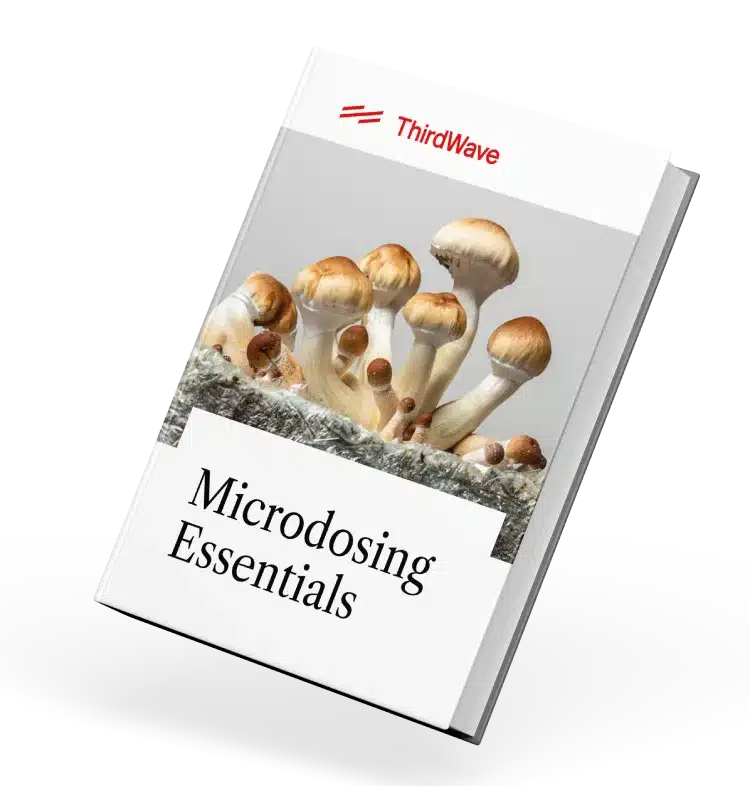

Master the Skill of Microdosing
Enter your info to start your journey on Third Wave's Microdosing Course! Discover a science-based framework for transformational microdosing.
"The course gave me hope, a new way from what I've read and researched before. It has content which any reader can relate to whether you're an addict, an alcoholic or someone suffering from depression or other mental or spiritual ailments. I now feel empowered to take responsibility for my life!"
-Melissa P.
Effects
03The science of microdosing psilocybin truffles
While there has been some recent research on microdosing, we know a lot more about what large doses of psychedelics do to the brain.
Much of what we understand about how psychedelics work involves serotonin, a chemical that is among the brain’s most important neurotransmitters. Serotonin affects nearly everything we do, from how we feel to how we process information. It keeps our brains ticking.
Psychedelics such as LSD and psilocybin share a similar structure to serotonin and mimics the chemical’s effects. This is why these substances have comparable effects to a full dose when microdosed, at least in the most important aspects described in the Benefits & Risks section of this guide. You can learn more about the differences between microdosing LSD and psilocybin here.
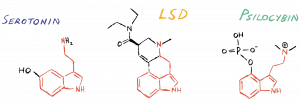
Because serotonin is so important to mood stabilization, common antidepressants (called Selective Serotonin Reuptake Inhibitors, or SSRIs) increase the levels of serotonin in the brain, which can make you feel happier.
Psychedelics work by mimicking serotonin. One of psilocybin’s main effects is to stimulate a serotonin receptor called “5-HT2A” located in the prefrontal cortex, which leads to two important results:
- The production of “Brain-Derived Neurotrophic Factor” (BDNF), a protein that is “like Miracle-Gro for your brain,” according to Waldman. BDNF stimulates growth, connections, and activity. [1]
- The increased transmission of “Glutamate,” a neurotransmitter responsible (in part) for important brain functions such as cognition, learning, and memory. [2]
Glutamate and BDNF work together in ways we’ve yet to fully understand, but it’s become clear that having more of each can lead to many of the benefits that microdosers are seeking. [3] In fact, a recent study found that low doses of LSD increased BDNF blood plasma levels in healthy volunteers, which suggests “a window of opportunity for a therapeutic response and cognitive enhancement,” according to the study’s authors.
Psychedelics also cause parts of the brain that don’t usually communicate with one another to start talking. These unique connections are formed by psychedelics’ ability to dampen the activity of an often over-used part of our brain called the “Default Mode Network” (DMN). [4] The DMN is responsible for many mental activities, including day-dreaming, self-reflection, and thinking about the past or the future. But research shows that a highly active DMN causes us to ruminate, over-analyze ourselves, and step out of the present moment to question the past and the future, all of which can make us unhappy. In fact, some studies suggest that depression is linked to an overactive DMN. [5] This helps explain why psychedelics could be used to combat depression and anxiety—as well as lead to insights and creative perspectives that may otherwise remain inaccessible.
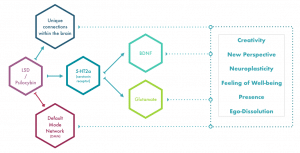
Grow 1 Year's Worth of Microdoses in Just 6 Weeks
Third Wave partnered with top mycologists to create the world’s easiest and best mushroom growing program (kit, course, and expert support).
- Pre-sterilized and sealed
(ready to use out of the box) - Step-by-step video and text course
- Access to growing expert in community
- Make your first harvest in 4-6 weeks
- Average yield is 1 - 4 ounces (28-108g)
- Fits in a drawer or closet
- Enter info for Third Wave discounts:
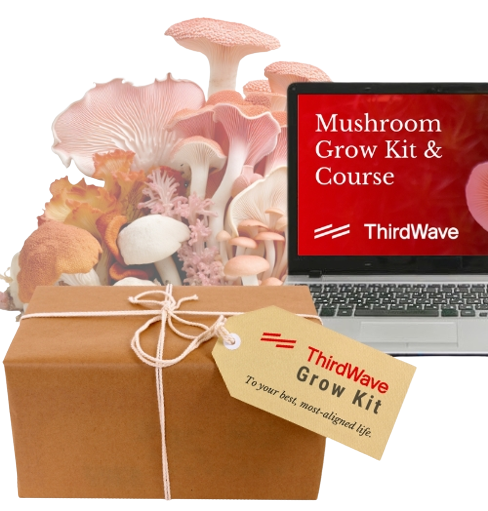
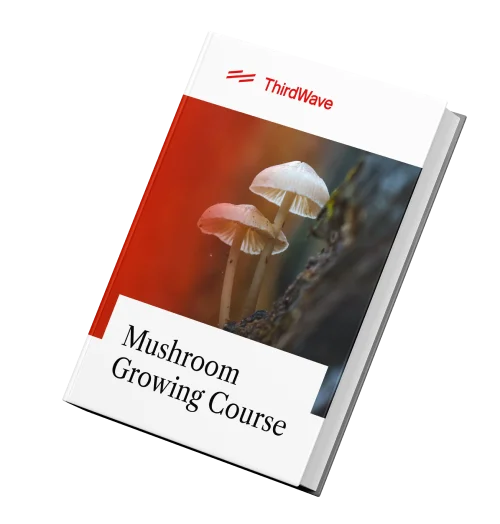
Grow 1 Year's Worth of Microdoses in Just 6 Weeks
Third Wave partnered with top mycologists to create the world’s easiest and best mushroom growing program (kit, course, and expert support).
- Pre-sterilized and sealed
(ready to use out of the box) - Step-by-step video and text course
- Access to experts in community
- Make your first harvest in 4-6 weeks
- Average yield is 1 - 4 ounces (28-108g)
- Fits in a drawer or closet
- Enter info for Third Wave discounts
Benefits & Risks
04Potential Benefits
There are many benefits to microdosing psilocybin truffles. But, at the risk of oversimplifying, most people microdose for two main reasons.
1: To reduce the frequency and intensity of undesirable states caused by various forms of “mental illness”, including:
- Depression
- Anxiety (i.e. Generalized or Social)
- ADD/ADHD
- Mood disorders
- PTSD
- Addiction
2: To increase the frequency and intensity of desirable states/outcomes:
- Creativity
- Energy
- Flow states
- Productivity/focus
- Improved relationships/increased empathy
- Athletic coordination
- Leadership development
Reports suggest that microdosing can improve creativity, productivity, and energy. Countless people also microdose to help them solve work-related problems, create new concepts, or simply to reduce procrastination. Microdosing can also help you by improving your social interaction skills, athletic performance, and spiritual awareness.
Here are a few testimonials from Third Wave survey respondents on how microdosing helped them reach desirable states:
“Microdosing psilocybin has opened my mind to new possibilities. Due to a scary cancer diagnosis 6 years ago, I began taking antidepressants. “Anti” is a good descriptor, because the medication did stop me from freaking out about death. However, “anti” is not “pro.” Psilocybin has reconnected me with my positive feelings of happiness, gratitude and joy. What a pleasure to feel those feelings again! I feel free, like I can think outside of the box, be more creative and express more positive feelings.”
“Microdosing completely reshaped my perception of my personal identity, allowing me to see more possibilities in my life. I feel more resilient and emotionally attuned. It’s shown me parts of myself that need healing and attention, and revealed the next steps I need to take in my journey. I began microdosing to rid myself of an adderall dependency/addiction that I picked up in college, and I’m happy to say I don’t feel addicted to adderall, or anything else anymore. I’m better at recognizing my needs and nurturing myself.”
To learn how entrepreneur Janet Chang microdosed to improve creativity and work performance, listen to our interview here.
Getting the most out of microdosing is really important – and depending on the reason you’re microdosing, you’ll need to prepare and integrate appropriately. Our official microdosing course will guide you through the various protocols for getting the most out of microdosing, specific to your needs.
Risks
By far, the riskiest thing about microdosing is the law. It’s crucial to check your local laws before microdosing, as the penalties for the possession of psilocybin can be harsh.
Aside from the legal risks, one can consider microdosing to be a safe, non-threatening introduction to the benefits of psychedelics.
Given the tremendous safety records of psilocybin, combined with the small dose amounts, microdosing appears to be a safe, measurable way to explore the incredible possibilities that psychedelics have to offer.
As can be seen by the chart below, comparing the relative harms of common substances, psilocybin is one of the safest substances you can find, biochemically and socially speaking. It’s much safer than alcohol.
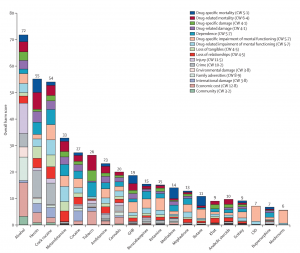
Having said that, psychedelics are powerful substances, and even microdoses have a risk potential.
Emotional turbulence or anxiety is possible while microdosing, largely due to psychedelics’ ‘amplifying effect’. Psilocybin truffles tend to amplify your current mood, rather than act as a stimulant or numbing agent. For this reason, it is important to assess your mindset before consuming a microdose. We also recommend discussing the risks with your physician if you suffer from psychosis, schizophrenia or severe anxiety, before you decide to begin microdosing. When overdone, microdosing can lead to manic states, which could exacerbate underlying conditions.
Since there is no clinical research on the safety of microdosing, it’s best not to microdose for extended periods of time (longer than a few months). There is a potential heart risk of taking too many large doses of psychedelics over a long period of time – although we don’t know how this translates to microdosing.
Mixing psilocybin with pharmaceuticals—and especially antidepressants—could also be risky. Psilocybin works in part by activating the serotonergic receptors in the brain. Because most conventional antidepressants also work on the serotonergic system, combining these medications with psilocybin could overstimulate the body. Selective Serotonin Reuptake Inhibitors (SSRIs), for example, are the most common form of antidepressant and prevent your brain from clearing excess serotonin. Because psilocybin increases the production of serotonin, combining the two can cause serotonin syndrome, which can be fatal. [6]
Other classes of antidepressants that overlap with the effects of psilocybin include Serotonin-Norepinephrine Reuptake Inhibitors (SNRIs), Monoamine Oxidase Inhibitors (MAOIs), Tricyclic Antidepressants (TCAs), and Tetracyclic Antidepressants (TeCAs). Like SSRIs, these should not be combined with psilocybin.
So far, research has not shown that psilocybin works on the norepinephrinergic or dopaminergic neurotransmitter systems, meaning antidepressants that do work on these systems (Norepinephrine Reuptake Inhibitors and Norepinephrine-Dopamine Reuptake Inhibitors) may not have an adverse effect. However, because we don’t know for sure, it’s best to avoid this combination, too.
Grow 1 Year's Worth of Microdoses in Just 6 Weeks
Third Wave partnered with top mycologists to create the world’s easiest and best mushroom growing program (kit, course, and expert support).
- Pre-sterilized and sealed
(ready to use out of the box) - Step-by-step video and text course
- Access to growing expert in community
- Make your first harvest in 4-6 weeks
- Average yield is 1 - 4 ounces (28-108g)
- Fits in a drawer or closet
- Enter info for Third Wave discounts:


Grow 1 Year's Worth of Microdoses in Just 6 Weeks
Third Wave partnered with top mycologists to create the world’s easiest and best mushroom growing program (kit, course, and expert support).
- Pre-sterilized and sealed
(ready to use out of the box) - Step-by-step video and text course
- Access to experts in community
- Make your first harvest in 4-6 weeks
- Average yield is 1 - 4 ounces (28-108g)
- Fits in a drawer or closet
- Enter info for Third Wave discounts
Therapeutic Use
05If you microdose while attending therapy, you may find that issues and topics that previously felt difficult to reach are suddenly accessible. You may also notice creative insight into yourself, your past, and your relationships that you didn’t before.
Here are a few testimonials from Third Wave survey respondents on how microdosing helped them overcome undesirable states:
“Microdosing doesn’t allow me to be anywhere else but in the present moment. This has helped me tremendously with my anxiety and depression. I am incapable of worrying about what’s going to happen next week, tomorrow, or even five minutes from now. I can function without anxiety for the first time in years. I feel that my attention span is greater, I’m concentrating like never before. When I was suffering with pain I was given a lot of prescription pain pills and was quickly becoming addicted to them. Microdosing instantly helped me stop taking the several pills a day I was taking just so I could get out of bed, and I haven’t touched them since.”
“I have fought depression for some 6-7 years since adolescence, microdosing has, so far, consistently helped me get on with my day-to-day, just as much on no MD days as MD days. This also applies to Social & General Anxiety which has been less severe but experienced for the same period.”
“I overcame my depression with microdosing because I can consistently be productive and happy with it as a creative booster. It also eliminates any anxiety I get because I never used to raise my hand in class. I smoke a lot of cannabis and it’s unhealthy to overindulge. I found microdosing to make me feel the need to be productive so I smoke much less when I microdose and don’t indulge just to smoke.”
If you want to learn more about how microdosing can help you within a therapeutic container, get access to Third Wave’s Official Microdosing Course.
Personal Growth
06Flow states
At some point in our lives, most of us have likely experienced “flow,” or the mental state in which a person is fully immersed in a feeling of energized focus, presence, involvement, and enjoyment in the process of an activity. This can be the surfer effortlessly riding a big wave, the salesman elegantly working the room, or the writer who looks up from the page to realize night has fallen.
Simply put, flow is one of the great experiences of being human. We have no clinical evidence to suggest that microdoses of psychedelics can induce flow states, but preliminary research has shown that microdosing psilocybin can increase creativity. A 2018 study, for example, found that both convergent and divergent thinking performance was improved after taking a dose of psilocybin truffles ranging from .22g to .44g (depending on body weight). [7]
Studies have also shown that moderate doses of psilocybin cause brain waves to shift toward alpha oscillations, which is also seen in the transition to a flow state. Additionally, higher levels of serotonin are found during flow states.
Unlike LSD, however, psilocybin appears to interact minimally and only indirectly with dopamine, another neurotransmitter associated with flow states. This interaction may be minimal in the microdose range.
Perhaps most important, though, psychedelics’ ability to quiet the DMN creates an opportunity for our brains to make unique connections between areas that don’t usually communicate. This is crucial to accessing flow states.
Since we know that moderate doses of psychedelics can induce similar effects to a flow state in the brain, it seems likely that a regular microdosing regimen could begin to shift our awareness in the direction of flow.
Microdosing & Leadership
Change and innovation are happening faster than ever these days, and leaders need to adapt quickly. Great leaders must come up with creative solutions to unexpected issues and problems, turning potential setbacks to their advantage. Staying at the forefront of any field requires mastering new technology and being open to novel ways of accomplishing tasks, taking both short and long term needs into account.
Additionally, modern leadership is becoming less hierarchical, dominant, and aggressive (archetypal “masculine” traits) and increasingly requires the ability to cultivate space to allow the best people to step in and contribute their highest gifts (archetypal “feminine” characteristics).
Microdosing helps to accelerate this developmental process for the next generation of leaders by facilitating enhanced creativity, mental flexibility, and honest self-reflection. Microdosing also improves self-confidence, which enables you to be more in touch with your emotions and helps you better communicate.
To learn more about how microdosing can help with professional development, check out this talk from Third Wave founder Paul Austin.
Master the Skill of Microdosing
Enter your info to start your journey on Third Wave's Microdosing Course! Discover a science-based framework for transformational microdosing.
"The course gave me hope, a new way from what I've read and researched before. It has content which any reader can relate to whether you're an addict, an alcoholic or someone suffering from depression or other mental or spiritual ailments. I now feel empowered to take responsibility for my life!"
-Melissa P.


Master the Skill of Microdosing
Enter your info to start your journey on Third Wave's Microdosing Course! Discover a science-based framework for transformational microdosing.
"The course gave me hope, a new way from what I've read and researched before. It has content which any reader can relate to whether you're an addict, an alcoholic or someone suffering from depression or other mental or spiritual ailments. I now feel empowered to take responsibility for my life!"
-Melissa P.
Macrodosing
07Evidence is also strong that a psilocybin experience can be a powerful driver for personal growth. In fact, one recent study published in the Journal of Psychopharmacology found that “a single dose of psilocybin produced substantial and enduring decreases in depressed mood and anxiety along with increases in quality of life.”
Research has also shown that psilocybin can be used to enhance one’s spiritual practice. In a recent study, 75 participants engaged in a six-month spiritual course involving meditation, awareness, and self-reflection. During the course, participants were given either a low or high dose of psilocybin. At the end of the six months, the participants given the high dose of psilocybin showed significantly greater improvements in measures of spirituality such as interpersonal closeness, life meaning, death transcendence, and forgiveness.
With all this in mind, many people believe psilocybin (and other psychedelics) could be a key component of self-improvement and self-optimization. By occasioning the experience of feeling connected to the universe (in whatever individual form that takes) and confronting the deepest part of yourself, many believe psilocybin can help you take the necessary steps to become the best version of yourself you can be.
Considering a psilocybin experience for personal growth? Check out Third Wave’s vetted guide of psilocybin retreat centers around the world.
Legality
08Back in the day, Psilocybin Mushrooms were legal to consume in the Netherlands, which was the number one commercial producer in the world. However, in 2008, in response to a number of media stories about mushroom-related deaths and incidents, the Dutch government banned their sale. Somehow, truffles were left out of this amendment.
For this reason, if you live in Europe, you have the option of purchasing psilocybin truffles legally in the Netherlands. In a few other countries, such as Austria, Italy, Czech Republic, Portugal and Spain, possession and/or cultivation in limited quantities of psilocybin is legal or decriminalized.
History & Stats
09Dr. Fadiman’s book explores microdosing as a subculture of psychedelic use. While a number of indigenous cultures as well as modern professionals have utilized microdosing as a way to unlock a host of benefits, Dr. Fadiman’s book formally introduced the term “microdosing” into the psychedelic mainstream.
But Dr. Fadiman’s book didn’t just contribute a piece of terminology; it awakened the curiosity and imaginations of millions of people fascinated by the reports of experienced microdosers. It also provided a host of practical information for anyone that wanted to give it a try, much of which has been integrated into this course.
Dr. Fadiman’s ongoing research into microdosing serves as one of the few modern studies into the effects of microdosing specifically (most other research deals with larger doses for specific therapeutic outcomes).
Following the publication of The Psychedelic Explorer’s Guide, the next major boost in the public’s awareness of microdosing came from a podcast interview Dr. Fadiman gave with Tim Ferriss in March of 2015.
Ferriss, who rose to fame after authoring the bestseller “The Four Hour Work Week,” has an enormous audience of individuals interested in entrepreneurship, “biohacking,” self-experimentation, psychology, spirituality, and an array of additional subject matters that would predispose them to an interest in the benefits of microdosing.
His podcast interview with Dr. Fadiman blasted the core messages about microdosing contained in The Psychedelic Explorer’s Guide from a soapbox loud enough to significantly increase a basic awareness of the concept.
Soon after its air date, listeners of Ferriss’ podcast were not only starting to experiment with microdosing on their own; they were discussing it and sharing their curiosity with their own personal networks. Consequently, journalists began writing articles about microdosing, leading to even greater awareness and interest.
The most recent source of interest in microdosing came from Ayelet Waldman’s book “A Really Good Day: How Microdosing Made a Mega Difference in My Mood, My Marriage, and My Life,” published in February of 2016.
Waldman’s book discusses her 30 day protocol of microdosing with LSD to address a variety of psychological symptoms primarily caused by hormonal changes related to menopause.
Prior to microdosing, Waldman’s mood swings had become so severe as to put her marriage and relationship with her children at risk.
Afterwards, in an interview with Third Wave, she said, “This month changed my life, and I am sad every day that I can’t keep doing it legally.”
Now, tens of thousands of people around the globe are being turned on to microdosing – whether it’s for treating mental health problems, boosting creativity, or giving entrepreneurs new directions.
Grow 1 Year's Worth of Microdoses in Just 6 Weeks
Third Wave partnered with top mycologists to create the world’s easiest and best mushroom growing program (kit, course, and expert support).
- Pre-sterilized and sealed
(ready to use out of the box) - Step-by-step video and text course
- Access to growing expert in community
- Make your first harvest in 4-6 weeks
- Average yield is 1 - 4 ounces (28-108g)
- Fits in a drawer or closet
- Enter info for Third Wave discounts:


Grow 1 Year's Worth of Microdoses in Just 6 Weeks
Third Wave partnered with top mycologists to create the world’s easiest and best mushroom growing program (kit, course, and expert support).
- Pre-sterilized and sealed
(ready to use out of the box) - Step-by-step video and text course
- Access to experts in community
- Make your first harvest in 4-6 weeks
- Average yield is 1 - 4 ounces (28-108g)
- Fits in a drawer or closet
- Enter info for Third Wave discounts
FAQ
10Can psilocybin be detected in a drug test?
Psilocybin and its metabolites are not included in most standard drug screens; however, they are sometimes included in extended drug screens.
Is microdosing illegal?
Microdosing is not necessarily illegal. Several countries allow the cultivation and/or purchase of psilocybin truffles, as well as the purchase of LSD analogues. We do not condone microdosing where it is against the law, as penalties can be severe.
Is microdosing safe?
The riskiest thing about microdosing is its potentially illegal nature. Always be aware of your local laws and don’t undertake any illegal activities.
There are no clinical research studies on microdosing in humans. However, clinical studies of larger doses of LSD and psilocybin truffles have shown that these substances are extremely safe.
What remains an unknown is what effects frequent microdosing could have on the body. This is why we recommend microdosing for no longer than a few months at a time.
One thing is for certain – with microdosing, there is no risk of having a “bad trip” or experiencing intense psychedelic effects. Taking a microdose is the ideal way to be introduced to psychedelics safely and comfortably.
How do I get started with microdosing?
There are lots of things to cover before you get started with microdosing – depending on the reasons you’re interested in the first place.
Sign up to our extensive microdosing course to gain access to curated materials that will help you design the ideal microdosing regimen for your needs. You’ll also gain access to an exclusive community of enthusiastic, helpful microdosers.
Want to easily grow mushrooms at home?
Third Wave’s How to Grow Mushrooms Course and Grow Kit turn the daunting task of cultivating mushrooms into a simple one.
Our in depth guide and step-by-step videos will have you harvesting your own home-grown mushrooms in no time.
Footnotes
11[1] Ayelet Waldman (2016) “A Really Good Day: How Microdosing Made a Mega Difference in My Mood, My Marriage, and My life”
[2] Riedel, Platt & Micheau (2003) doi:10.1016/S0166-4328(02)00272-3
[3] Vollenweider & Kometer (2010) doi:10.1038/nrn2884
[4] Carhart-Harris et al. (2016) doi:10.1073/pnas.1518377113
[5] Sambataro et al. (2014) doi:10.1017/S0033291713002596
[6] https://observatory.synthesisretreat.com/can-you-take-shrooms-on-antidepressants
[7] https://link.springer.com/article/10.1007/s00213-018-5049-7
